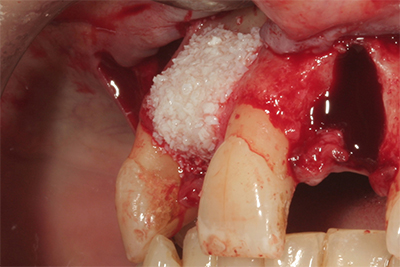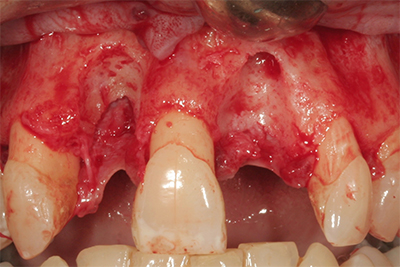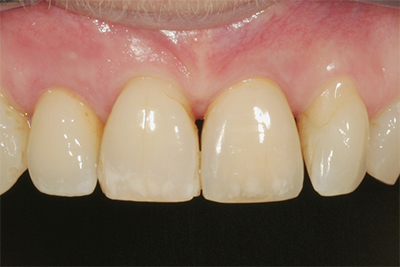Dr. Robert Oretti
Kurser på DFA 2019
Kirugi
Open wound healing concept
Bone grafting procedures are utilised whenever bone deficiencies are present. The timing of the bone grafting procedure can be either at the time of tooth removal or at a later date after primary healing of the site.
Bone grafting after primary healing – the staged approach – is often considered the gold standard with regards to achieving predictable guided bone regeneration. Complete flap closure over a bone graft leads to protection of the graft from external influences and promotes undisturbed healing.
However, this technique requires a period of healing following tooth extraction, and if the resulting bone defect will not allow for predictable implant placement, then a separate bone grafting procedure may be required. In such a scenario, the timing of implant placement can be many months after the initial removal of the tooth.
The open wound healing concept is well referenced in the literature and includes the application of a guided bone regeneration protocol at the same time as tooth removal. With correct application, the assimilation of the bone graft is not impeded or compromised despite the fact that primary closure of the soft tissues is not achieved. This technique ensures that there is no need to perform a block graft procedure and ensures that the mucogingival line is not disturbed or altered in position.
Du vil lære:
To understand the alveolar changes that occur after tooth removal and the common GBR strategies to deal with bone deficiencies
To be familiar with the rationale for choosing differing implant/bone grafting treatment options with an emphasis on evidence based dentistry.
To appreciate the role of differing treatment strategies that are utilised during the open wound healing concept to achieve predictable outcomes.
To be familiar with the procedural steps required to obtain passive closure over the bone graft and without disturbing the muco-gingival line.
Tandlæger
1,25 kursustimer
Dental Media Scenen
Fredag, 9.15 – 10.30
Kirugi
Open wound healing concept – Hands-on
When a tooth is removed the labial plate will remodel and the resulting ridge width will be diminished. If the labial plate was damaged or compromised prior to tooth removal, then the degree of remodeling can be significant. If the residual ridge width results in a one wall defect, then it may be necessary to perform a bone grafting procedure as a separate treatment to rebuild the ridge prior to implant placement at a later date.
The rationale for the open wound concept is to remove the tooth and rebuild the labial plate with a GBR procedure at the same time thereby reducing the degree of labial plate remodeling.With this treatment modality, the width of the ridge is maintained after tooth removal and eliminates the potential scenario of the one walled defect.
The GBR procedure is performed at the same time as removal of the tooth and therefore the bone graft is not completely submerged under the gums – the open wound concept. This workshop will focus on the techniques employed to rebuild the socket and close the soft tissues but without full submergence of the bone graft under the soft tissues.
OBS:
- Max 30 deltagere – medbring lup-briller
- Du kan kun deltage på hands-on delen, hvis du har været på formiddagens teori-indlæg på Dental Media Scenen.
- Der trækkes lod om eftermiddagens pladser efter teori-indlægget på Dental Media Scenen.
Du vil lære:
To understand the alveolar changes that occur after tooth removal and the common GBR strategies to deal with bone deficiencies
To be familiar with the rationale for choosing differing implant/bone grafting treatment options with an emphasis on evidence based dentistry.
To appreciate the role of differing treatment strategies that are utilised during the open wound healing concept to achieve predictable outcomes.
To be familiar with the procedural steps required to obtain passive closure over the bone graft and without disturbing the muco-gingival line.
Tandlæger
3,5 kursustime
Hands-on området
Fredag, 13.30 – 15.15
Dr. Robert Oretti
Robert qualified at Kings College, London in 1987. After working in an orthodontic practice in Colchester for four years he moved to Newbury, Berkshire. Rob then spent the next 14 years working in a busy private practice where he built a reputation for treating complex cases involving cosmetic, implant and orthodontic treatments. At this time, Rob also became involved in teaching and mentoring and has taught many dentists on all aspects of cosmetic and dental implant therapies.
In 2006, Rob moved to Pentangle Dental Transformations – a purpose built centre for dentists to send their patients for implant and complex treatments. Rob now spends his time between treating these referred patients and teaching. Rob is currently a post graduate tutor for the Thames valley deanery, a mentor and faculty educator for the ADI (Association of Dental Implantology), a mentor and international speaker for the ITI (International team of Implantologists), a Royal College of Surgeons Examiner for the implant diploma (RCS Edin) as well as the Membership in Advanced General Dental Surgery (MAGDS Edin) and the current president of the British Academy of Aesthetic Dentistry (BAAD). He presents regularly at scientific meetings and has published several articles on implant therapy.





